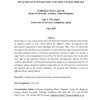Free Online Productivity Tools
i2Speak
i2Symbol
i2OCR
iTex2Img
iWeb2Print
iWeb2Shot
i2Type
iPdf2Split
iPdf2Merge
i2Bopomofo
i2Arabic
i2Style
i2Image
i2PDF
iLatex2Rtf
Sci2ools
94
Voted
CSDA
2008
2008
Modelling the US, UK and Japanese unemployment rates: Fractional integration and structural breaks
In this paper we use a general procedure for fractional integration and structural breaks at unknown points in time, which allows for different orders of integration and deterministic components in each subsample (see Gil-Alana, 2007). First, we extend this procedure to the non-linear case, and show by means of Monte Carlo experiments that the procedure performs well in a non-linear environment. Second, we apply it to test for a single break in the unemployment rate in the US, the UK and Japan. Our results shed some light on the empirical relevance of alternative unemployment theories for these countries. Specifically, a structuralist interpretation appears more appropriate for the US and Japan, whilst a hysteresis model accounts better for the UK experience (and also for the Japanese one in the second subsanple). We interpret these findings in terms of different labour market features.
| Added | 10 Dec 2010 |
| Updated | 10 Dec 2010 |
| Type | Journal |
| Year | 2008 |
| Where | CSDA |
| Authors | Guglielmo Maria Caporale, Luis A. Gil-Alana |
Comments (0)

